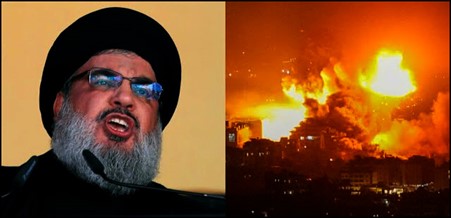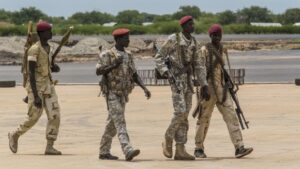The Attack
On the night of September 27, 2024, the Israeli Air Force bombed a built-up area in South Beirut, Lebanon. The aircraft, F-15E Strike Eagles, attacked in successive waves, dropping eighty bombs on at least four high-rise apartment buildings.
Beneath the buildings lay a deep, hardened bunker complex in which Hassan Nasrallah, leader of Hezbollah, was convening a senior leadership meeting. By some accounts, senior Iran Revolutionary Guard Corps (IRGC) officers were also in attendance.
The bombs were heavy-duty “bunker busters.” The explosions, which lit up the sky for miles, collapsed the buildings, penetrated the bunker complex, and wiped out those attending the meeting. Over the next few days, Hassan Nasrallah was confirmed killed.
Nasrallah was more than Hezbollah’s leader. He was an icon of support for the Palestinians across the Islamic world. His killing marks the most devastating blow to Hezbollah and Iran that Israel has ever struck. Israeli Prime Minister Netanyahu gave the order for the attack from his hotel in New York, where he was addressing the UN General Assembly. This coup has effectively secured his leadership for the next several years and emboldened Israel in its battle against Hamas, Hezbollah, and Iran.
Figure 1. Target area in southern Beirut. At least four buildings were collapsed in the attack.
The Bombs
Figure 1 shows the devastation wrought by the attack. At least four buildings in the city were completely collapsed. There is no final tally of casualties, but some reports estimate that at least one thousand were killed.
Senior Israeli officers told the New York Times that 80 bombs had been used in the attack. On this matter, reports are conflicting. Some accounts report that 80 tons of bombs were dropped on the target area. Others report that 80 two-thousand-pound bombs were dropped on the target area. We choose to believe the latter report, which appears to be sourced from the IDF itself. This article will examine the mechanism of the attack itself.
The Attack
On the night of September 27, 2024, the Israeli Air Force bombed a built-up area in South Beirut, Lebanon. The aircraft, F-15E Strike Eagles, attacked in successive waves, dropping eighty bombs on at least four high-rise apartment buildings.
Beneath the buildings lay a deep, hardened bunker complex in which Hassan Nasrallah, leader of Hezbollah, was convening a senior leadership meeting. By some accounts, senior Iran Revolutionary Guard Corps (IRGC) officers were also in attendance.
The bombs were heavy-duty “bunker busters.” The explosions, which lit up the sky for miles, collapsed the buildings, penetrated the bunker complex, and wiped out those attending the meeting. Over the next few days, Hassan Nasrallah was confirmed killed.
Nasrallah was more than Hezbollah’s leader. He was an icon of support for the Palestinians across the Islamic world. His killing marks the most devastating blow to Hezbollah and Iran that Israel has ever struck. Israeli Prime Minister Netanyahu gave the order for the attack from his hotel in New York, where he was addressing the UN General Assembly. This coup has effectively secured his leadership for the next several years and emboldened Israel in its battle against Hamas, Hezbollah, and Iran.
Figure 1. Target area in southern Beirut. At least four buildings were collapsed in the attack.
The Bombs
Figure 1 shows the devastation wrought by the attack. At least four buildings in the city were completely collapsed. There is no final tally of casualties, but some reports estimate that at least one thousand were killed.
Senior Israeli officers told the New York Times that 80 bombs had been used in the attack. On this matter, reports are conflicting. Some accounts report that 80 tons of bombs were dropped on the target area. Others report that 80 two-thousand-pound bombs were dropped on the target area. We choose to believe the latter report, which appears to be sourced from the IDF itself. This article will examine the mechanism of the attack itself.
The bombs were probably of two types: Mark 84 bombs and BLU-109 bombs, both equipped with JDAM (GPS-guided) smart bomb kits for precision strikes. It is important to make a distinction between the weight of the bomb and the weight of explosive in the bomb’s warhead.
Figure 2. MK-84 and BLU-109 Bombs. Source: GlobalSecurity.Org
Notice that both warheads have a total weight approaching 2,000 pounds. However, the MK-84 contains 965 pounds of explosives, and the BLU-109 contains 535 pounds of explosives. For this reason, the statement “80 two-thousand-pound bombs were used” makes much more sense than the statement “80 tons of bombs were used.” The BLU-109 has better penetrative ability. As we shall see, there was every reason to use both types of bombs in the attack.
The Mechanism of Attack
Imagine what a crowded, built-up city block looks like. Look at Figure 1. Imagine four buildings that used to stand where that hole is. Surrounded by other buildings. Think back, if you will, to September 11, 2001, and the collapse of the World Trade Center. The way the buildings came down.
There was a Hezbollah bunker complex buried deep under those buildings. We do not know how deep, but the Israeli Air Force certainly had intelligence that gave it some idea so that it could select the weapons used.
The IAF did not just randomly drop eighty tons of bombs on the target. The IAF had to penetrate the underground bunker to kill Nasrallah. To reach the bunker, it had to get through the buildings above and the concrete covering it. The following steps would have had to occur:
Collapse the four buildings whose footprint covered the bunker.
Clear the debris of the buildings out of the way. Literally blow debris aside.
Penetrate the surface and the concrete bunker roof to kill everyone inside.
Step One would have effectively been a controlled demolition. The IAF would have sourced architectural blueprints of the buildings and studied points of vulnerability. They would have made decisions as to where to target their smart bombs to collapse the buildings most efficiently.
Step Two requires ground bursts of less penetrative bombs. Effectively, the attackers are just kicking rubble out of the way. When this is done, Step Three brings up the heavy artillery to either penetrate right into the bunker complex, or cause the earth and concrete roof to fall in on the helpless occupants.
Now we can see why the IAF may have had reason to use at least two types of bombs. The MK-84s which have less penetrative ability than the BLU-109s, would have been used to collapse the buildings into their footprint (this would have looked much like the collapse of the twin towers). The collapse of the buildings would have left a pile of rubble covering the footprint that would continue to shield the underground bunker. The MK-84s, or similar, might also have been used to blast the debris out of the way.
Finally, once the rubble had been blasted out of the way, BLU-109s (see Figure 3), with their higher penetrative ability might then have been used to penetrate the earth and blast through the concrete roof of the bunker to kill all within.
Figure 3. F-15 Strike Eagle with BLU-109 Bunker Buster bomb
The Result
The result of the attack is shown in Figure 1. Four buildings don’t exist anymore. It is interesting to note that the rubble of the buildings, which could not have been completely cleared away in the 72 hours since the attack, looks like it has collapsed into the crater formed by the blasts. It’s filled in what used to be the bunker complex.
On Sunday, September 29, the body of Hassan Nasrallah was recovered. It bore no wounds, and Reuters reported that the cause of death appeared to be blunt trauma from the force of the blast.
It looks like one of the BLU-109s penetrated the complex, and the explosive shock wave killed Hezbollah’s leader.
About the Author
You may reach Cameron Curtis at: [email protected]
Check out his new Breed thriller, BLOWBACK, here: BLOWBACK by Cameron Curtis, available for download now at just $0.99
Pick up your copy today from Amazon.



